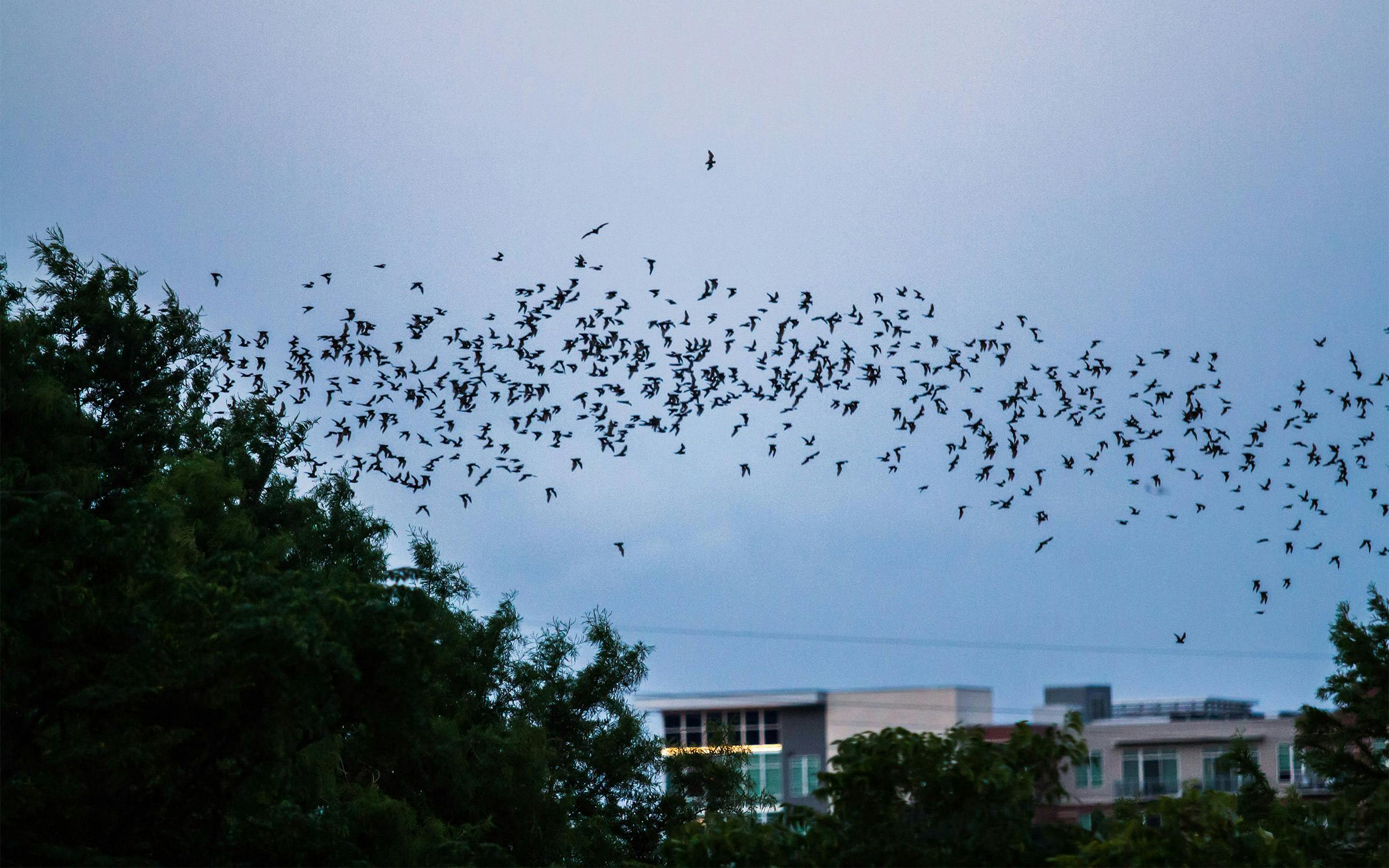As dusk settled over a Fort Worth city park in June 2022, Manuel de Oyarzabal Barba joined a rotating crew of collaborators for a ritual the group would repeat multiple times a week until September. The team set up its equipment: two large thermal cameras and a microphone connected to a field-recording system. That summer and the following spring, de Oyarzabal Barba, then a master’s student in environmental science at Texas Christian University, and his colleagues made repeat visits to thirty sites across two Tarrant County parks, where passersby often mistook their high-tech gear for telescopes.
“People thought we were looking at the moon,” de Oyarzabal Barba said, adding that parkgoers usually reacted with fear when he explained that the team was recording bats in flight. “Since the bats are small and it’s dark, people don’t really realize they’re there.”
While the Mexican free-tailed bats under the Congress Avenue Bridge are some of Austin’s most beloved celebrity residents, countless other bat populations are unsung heroes in Texas cities. “If we don’t have bats, a lot of other things don’t happen,” said Kate Rugroden of Bat World Sanctuary, a rescue group based in Weatherford, just west of Fort Worth. Bats belong to a category known as keystone species, she explained, meaning that they play disproportionately important (and necessary) roles in their ecosystems.
A single bat can eat three thousand insects per night (sometimes much more), providing crucial pest control. That’s especially important in Texas, which reported more cases of West Nile virus disease, a mosquito-borne illness, than any other state this year. The more insects bats eat, the less humans must rely on toxic chemical pesticides. A new study from a researcher at the University of Chicago concluded that where bat populations declined because of the fungal disease white-nose syndrome, farmers in the United States used more insecticides, a trend linked to higher rates of infant mortality. Bats also pollinate plants and enrich the soil with their droppings, or guano, which can act as a fertilizer.
Bat populations face numerous threats, including white-nose syndrome and severe weather caused by climate change. Urban development has also disrupted bat habitats, leaving bats with fewer options when finding food and sheltering from predators. This process, known as habitat fragmentation, can drive bats and other wildlife out of communities. Planting more trees might help, but it’s not that simple, because bats are choosy. De Oyarzabal Barba’s study, published in September in the journal Wildlife Biology, found that bats preferred continuous stretches of tall trees that offered consistent canopy cover, as gaps in tree corridors could leave bats exposed to predators. But overly dense canopies were also a problem. Excessive clutter from branches served as an obstacle for bats that discouraged transit, suggesting a need for regular trimming.
Tory Bennett, one of de Oyarzabal Barba’s advisers and an expert in how land-use changes affect wildlife, cautions against a one-size-fits-all approach to bat conservation, because the habits of each species are slightly different. For example, hoary bats prefer to fly above the tree canopy, while eastern red bats fly along the sides of trees. To create urban forests that work for all the bats in a community, she recommends designing tree corridors with the pickiest species in mind.
The bat with the most particular needs in the team’s study was also the most common species in the Dallas–Fort Worth area: the evening bat. “If you’ve covered the needs of evening [bats], you’re most likely covering all the needs for all the other species,” Bennett said. Indeed, the researchers recorded bat calls at each study site and found that corridors with a greater amount of bat traffic also attracted a more diverse array of species.
Bennett’s team, which also plans to study how bats find water sources, forage for food, and roost in urban areas, aims to eventually develop recommendations for city planners and residents to make communities easier for bats to navigate. The conclusions may have broader implications for urban ecosystems. If bats can move through an area, “it’s very likely that there’s good connectivity for the rest of the wildlife,” de Oyarzabal Barba said.
These efforts reflect a growing awareness of how habitat fragmentation affects animals, according to Eric Wettengel, the urban forestry manager at the Texas Trees Foundation. He attributes much of the initial interest in creating travel routes for wildlife to the promotion of the monarch butterfly, which gave the public a charismatic species to rally around. Bats have already benefited from the push to address habitat fragmentation in recent years. Since 2019, the Texas Department of Transportation has installed dozens of man-made roosts called bat boxes along bridges and highways throughout the state.
While concerned citizens, nonprofits, and government agencies can promote movement corridors for wildlife, Wettengel notes that the fact that over 96 percent of Texas land is privately owned complicates habitat-restoration efforts. “A lot of decisions [will] be left up to private landowners and developers,” he said, adding that the Texas Trees Foundation is involved in outreach to those groups.
Bennett hopes to turn homeowners into conservation allies by helping them fall in love with bats. “Just showing a picture of an eastern red [bat] changes people’s minds, because that little furry, cute red thing makes people go, ‘Wait, what? That’s a bat?’ ” she said. “They all look like sky puppies.” But she acknowledged that winning over everyone is a gradual process. “You have to do that neighborhood by neighborhood. . . . It takes a lot of work.”

